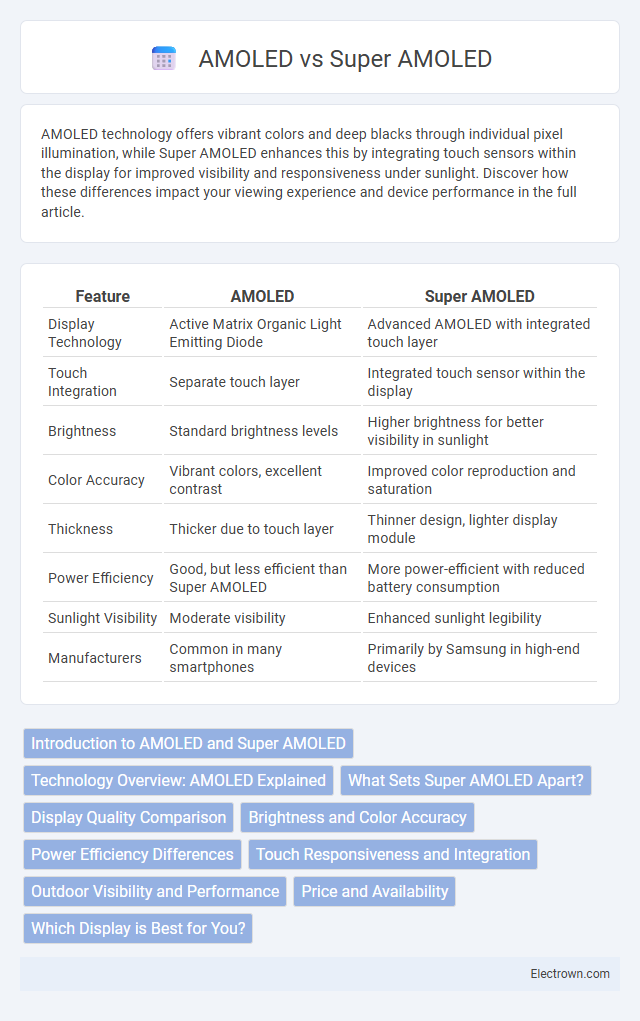AMOLED technology offers vibrant colors and deep blacks through individual pixel illumination, while Super AMOLED enhances this by integrating touch sensors within the display for improved visibility and responsiveness under sunlight. Discover how these differences impact your viewing experience and device performance in the full article.
Table of Comparison
| Feature | AMOLED | Super AMOLED |
|---|---|---|
| Display Technology | Active Matrix Organic Light Emitting Diode | Advanced AMOLED with integrated touch layer |
| Touch Integration | Separate touch layer | Integrated touch sensor within the display |
| Brightness | Standard brightness levels | Higher brightness for better visibility in sunlight |
| Color Accuracy | Vibrant colors, excellent contrast | Improved color reproduction and saturation |
| Thickness | Thicker due to touch layer | Thinner design, lighter display module |
| Power Efficiency | Good, but less efficient than Super AMOLED | More power-efficient with reduced battery consumption |
| Sunlight Visibility | Moderate visibility | Enhanced sunlight legibility |
| Manufacturers | Common in many smartphones | Primarily by Samsung in high-end devices |
Introduction to AMOLED and Super AMOLED
AMOLED (Active Matrix Organic Light Emitting Diode) technology uses an active matrix of OLED pixels that emit light individually, offering vibrant colors, deep blacks, and energy efficiency. Super AMOLED enhances this by integrating the touch sensor directly on the display layer, reducing thickness, improving screen visibility in sunlight, and delivering more responsive touch performance. Samsung pioneered Super AMOLED to elevate user experience through superior display brightness and reduced power consumption compared to standard AMOLED screens.
Technology Overview: AMOLED Explained
AMOLED (Active Matrix Organic Light Emitting Diode) technology features a layer of organic compounds that emit light when an electric current passes through them, enabling vibrant colors and deep blacks without the need for a backlight. Super AMOLED builds on this by integrating the touch sensor directly into the display layer, reducing thickness and improving sunlight visibility and touch responsiveness. Your device's display quality can significantly benefit from Super AMOLED, offering enhanced brightness, energy efficiency, and sharper images compared to standard AMOLED panels.
What Sets Super AMOLED Apart?
Super AMOLED integrates the touch sensor directly into the display rather than layering it on top, resulting in a thinner screen with improved touch responsiveness. This technology enhances visibility in bright sunlight and delivers deeper blacks and more vibrant colors due to its advanced pixel architecture. The reduced reflection and higher contrast ratio distinguish Super AMOLED displays from standard AMOLED panels, offering superior visual performance.
Display Quality Comparison
AMOLED displays offer vibrant colors and deep blacks due to their individual pixel illumination, while Super AMOLED enhances this technology by integrating the touch layer directly into the screen, resulting in improved brightness, reduced glare, and better outdoor visibility. Super AMOLED also delivers higher contrast ratios and more accurate color reproduction, making images crisper and more vivid compared to standard AMOLED screens. Your viewing experience benefits from this advanced display quality with better clarity and responsiveness, especially under bright lighting conditions.
Brightness and Color Accuracy
Super AMOLED displays integrate touch sensors directly into the screen, enhancing brightness by reducing layers that cause light loss, resulting in up to 30% higher luminance compared to traditional AMOLED panels. This technology also improves color accuracy by offering deeper blacks and more vibrant colors through better pixel control and reduced reflection. The combination of increased brightness and precise color reproduction makes Super AMOLED ideal for outdoor visibility and immersive visual experiences.
Power Efficiency Differences
Super AMOLED displays integrate the touch sensor layer directly into the screen, reducing light reflection and improving power efficiency compared to traditional AMOLED panels. This design allows Super AMOLED screens to consume less energy during bright scenes by increasing screen visibility without higher backlighting levels. The reduced layer count and enhanced display brightness contribute to longer battery life in devices equipped with Super AMOLED technology.
Touch Responsiveness and Integration
Super AMOLED displays feature an integrated touch sensor directly embedded into the screen, resulting in improved touch responsiveness and reduced screen thickness compared to traditional AMOLED panels. This integration enhances touch sensitivity by detecting input faster and more accurately, providing smoother gesture recognition and minimizing latency. Consequently, Super AMOLED technology delivers a more seamless and precise touch experience, ideal for high-performance smartphones and tablets.
Outdoor Visibility and Performance
Super AMOLED displays offer superior outdoor visibility by integrating the touch layer directly into the screen, reducing reflections and increasing brightness compared to standard AMOLED panels. The enhanced performance of Super AMOLED ensures more vivid colors and sharper images even under direct sunlight, making it ideal for outdoor use. If you frequently use your device outdoors, choosing a Super AMOLED screen significantly improves readability and overall visual experience.
Price and Availability
AMOLED displays generally come at a lower price point than Super AMOLED screens due to simpler manufacturing processes and fewer integrated components. Super AMOLED technology, which integrates touch sensors directly into the display layer, tends to be pricier and less widely available in budget devices. You can find AMOLED panels more commonly in mid-range smartphones, while Super AMOLED is predominantly featured in premium models from brands like Samsung.
Which Display is Best for You?
Super AMOLED displays integrate the touch sensor directly into the screen, resulting in thinner, brighter, and more power-efficient panels compared to standard AMOLED technology. You will notice more vibrant colors, deeper blacks, and better visibility in sunlight with Super AMOLED, making it ideal for outdoor use and extended screen time. Choosing Super AMOLED enhances your viewing experience with improved performance and battery life, especially if you prioritize display quality and device portability.
AMOLED vs Super AMOLED Infographic

 electrown.com
electrown.com